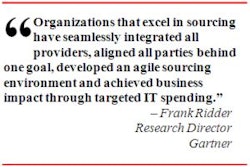Singapore — September 9, 2009 — The Asia Pacific aviation industry is reeling from the effects of the current economic decline, with more than 20 airlines filing for bankruptcy. The industry lost more than 180,000 jobs and a staggering $5.8 billion in 2008 alone and is anticipated to lose another $2.5 billion in 2009. With no likely improvements in the economic climate until 2010, the aviation industry is working on implementing dynamic and innovative solutions with a strong promise of return on investment (ROI) to remain competitive and profitable.
Some aviation companies are looking at leveraging technologies such as RFID to raise efficiency levels, reduce wastage and increase security. Initial results have shown that RFID has considerable potential to save costs, which is pivotal for long-term sustainability and profitability within the aviation industry.
New analysis from Frost & Sullivan, "Asia Pacific RFID Aviation Market," finds that the market earned revenues of $27.3 million in 2008 and estimates this to reach $188.3 million in 2015.
Despite their strong need to achieve operational efficiency, the total cost of ownership of RFID technology discourages several users from investing in it. This is a significant issue considering certain applications such as baggage handling require not only readers but also high volumes of tags to keep track of the baggage.
In addition, system integration with the existing back-end systems could be prohibitively expensive, particularly when there is a credit crunch. RFID vendors need to allay end users' fears by promoting the technology's ability to dual up and incorporate barcodes, ensuring that the track and trace function is available even when a particular location is not RFID-enabled.
"Further, RFID's capabilities to converge with other technologies such as sensors enable a new range of applications," says Frost & Sullivan Research Analyst Richard Sebastian. "RFID can be used to detect a diverse range of environmental parameters such as temperature, humidity and vibration, thus increasing the possibilities of this technology's usage within the aviation industry."
The market has received the backing of various governments and industry-based associations such as the International Air Travel Association (IATA) and the Federal Aviation Administration (FAA), which have been investigating and promoting RFID's usage within the aviation industry. Stakeholders within the aviation industry have begun pilot testing RFID, and many have been satisfied with the initial results, leading to full-scale rollouts.
The ratification of various standards governing RFID technology will also go a long way in acquiring more customers from the aviation industry.
"Through the formation of various standards, RFID companies can overcome interoperability issues and even ensure competitive pricing, as end users will not be locked to a single vendor's products," notes the analyst. "Moreover, considering application within the aviation industry is also likely to include open-loop systems as it is vital for all stakeholders to be able to use a system that can work seamlessly anywhere."
The report "Asia Pacific RFID Aviation Market" is available through Frost & Sullivan's Automatic Identification & Security Growth Partnership Services program.
Some aviation companies are looking at leveraging technologies such as RFID to raise efficiency levels, reduce wastage and increase security. Initial results have shown that RFID has considerable potential to save costs, which is pivotal for long-term sustainability and profitability within the aviation industry.
New analysis from Frost & Sullivan, "Asia Pacific RFID Aviation Market," finds that the market earned revenues of $27.3 million in 2008 and estimates this to reach $188.3 million in 2015.
Despite their strong need to achieve operational efficiency, the total cost of ownership of RFID technology discourages several users from investing in it. This is a significant issue considering certain applications such as baggage handling require not only readers but also high volumes of tags to keep track of the baggage.
In addition, system integration with the existing back-end systems could be prohibitively expensive, particularly when there is a credit crunch. RFID vendors need to allay end users' fears by promoting the technology's ability to dual up and incorporate barcodes, ensuring that the track and trace function is available even when a particular location is not RFID-enabled.
"Further, RFID's capabilities to converge with other technologies such as sensors enable a new range of applications," says Frost & Sullivan Research Analyst Richard Sebastian. "RFID can be used to detect a diverse range of environmental parameters such as temperature, humidity and vibration, thus increasing the possibilities of this technology's usage within the aviation industry."
The market has received the backing of various governments and industry-based associations such as the International Air Travel Association (IATA) and the Federal Aviation Administration (FAA), which have been investigating and promoting RFID's usage within the aviation industry. Stakeholders within the aviation industry have begun pilot testing RFID, and many have been satisfied with the initial results, leading to full-scale rollouts.
The ratification of various standards governing RFID technology will also go a long way in acquiring more customers from the aviation industry.
"Through the formation of various standards, RFID companies can overcome interoperability issues and even ensure competitive pricing, as end users will not be locked to a single vendor's products," notes the analyst. "Moreover, considering application within the aviation industry is also likely to include open-loop systems as it is vital for all stakeholders to be able to use a system that can work seamlessly anywhere."
The report "Asia Pacific RFID Aviation Market" is available through Frost & Sullivan's Automatic Identification & Security Growth Partnership Services program.



![Pros To Know 2026 [color]](https://img.sdcexec.com/mindful/acbm/workspaces/default/uploads/2025/08/prostoknow-2026-color.mduFvhpgMk.png?auto=format%2Ccompress&bg=fff&fill-color=fff&fit=fill&h=100&q=70&w=100)







![Pros To Know 2026 [color]](https://img.sdcexec.com/mindful/acbm/workspaces/default/uploads/2025/08/prostoknow-2026-color.mduFvhpgMk.png?ar=16%3A9&auto=format%2Ccompress&bg=fff&fill-color=fff&fit=fill&h=135&q=70&w=240)






